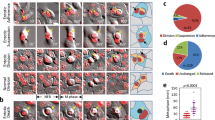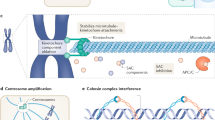Abstract
Aneuploidy is common in human tumours and is often indicative of aggressive disease. Aneuploidy can result from cytokinesis failure, which produces binucleate cells that generate aneuploid offspring with subsequent divisions. In cancers, disruption of cytokinesis is known to result from genetic perturbations to mitotic pathways or checkpoints. Here we describe a non-genetic mechanism of cytokinesis failure that occurs as a direct result of cell-in-cell formation by entosis. Live cells internalized by entosis, which can persist through the cell cycle of host cells, disrupt formation of the contractile ring during host cell division. As a result, cytokinesis frequently fails, generating binucleate cells that produce aneuploid cell lineages. In human breast tumours, multinucleation is associated with cell-in-cell structures. These data define a previously unknown mechanism of cytokinesis failure and aneuploid cell formation that operates in human cancers.
This is a preview of subscription content, access via your institution
Access options
Subscribe to this journal
Receive 12 print issues and online access
$209.00 per year
only $17.42 per issue
Buy this article
- Purchase on Springer Link
- Instant access to full article PDF
Prices may be subject to local taxes which are calculated during checkout





Similar content being viewed by others
References
Rajagopalan, H. & Lengauer, C. Aneuploidy and cancer. Nature 432, 338–341 (2004).
Weaver, B. A. & Cleveland, D. W. Does aneuploidy cause cancer? Curr. Opin. Cell Biol. 18, 658–667 (2006).
Pinto, A. E., Andre, S., Pereira, T., Silva, G. & Soares, J. DNA flow cytometry but not telomerase activity as predictor of disease-free survival in pT1-2/N0/G2 breast cancer. Pathobiology 73, 63–70 (2006).
Araujo, S. E., Bernardo, W. M., Habr-Gama, A., Kiss, D. R. & Cecconello, I. DNA ploidy status and prognosis in colorectal cancer: a meta-analysis of published data. Dis. Colon Rectum 50, 1800–1810 (2007).
Suehiro, Y. et al. Aneuploidy predicts outcome in patients with endometrial carcinoma and is related to lack of CDH13 hypermethylation. Clin. Cancer Res. 14, 3354–3361 (2008).
Susini, T. et al. Ten-year results of a prospective study on the prognostic role of ploidy in endometrial carcinoma: DNA aneuploidy identifies high-risk cases among the so-called ‘low-risk’ patients with well and moderately differentiated tumors. Cancer 109, 882–890 (2007).
Pinto, A. E., Monteiro, P., Silva, G., Ayres, J. V. & Soares, J. Prognostic biomarkers in renal cell carcinoma: relevance of DNA ploidy in predicting disease-related survival. Int. J. Biol. Markers 20, 249–256 (2005).
Ganem, N. J., Godinho, S. A. & Pellman, D. A mechanism linking extra centrosomes to chromosomal instability. Nature 460, 278–282 (2009).
Ganem, N. J., Storchova, Z. & Pellman, D. Tetraploidy, aneuploidy and cancer. Curr. Opin. Genet. Dev. 17, 157–162 (2007).
Boveri, T. The Origin of Malignant Tumors (Williams and Wilkins, 1929).
King, R. W. When 2+2=5: the origins and fates of aneuploid and tetraploid cells. Biochim. Biophys. Acta 1786, 4–14 (2008).
Fujiwara, T. et al. Cytokinesis failure generating tetraploids promotes tumorigenesis in p53-null cells. Nature 437, 1043–1047 (2005).
Nadler, Y. et al. Expression of Aurora A (but not Aurora B) is predictive of survival in breast cancer. Clin. Cancer Res. 14, 4455–4462 (2008).
Wang, X. et al. Overexpression of aurora kinase A in mouse mammary epithelium induces genetic instability preceding mammary tumor formation. Oncogene 25, 7148–7158 (2006).
Casenghi, M. et al. p53-independent apoptosis and p53-dependent block of DNA rereplication following mitotic spindle inhibition in human cells. Exp. Cell Res. 250, 339–350 (1999).
Tsuiki, H. et al. Mechanism of hyperploid cell formation induced by microtubule inhibiting drug in glioma cell lines. Oncogene 20, 420–429 (2001).
Minn, A. J., Boise, L. H. & Thompson, C. B. Expression of Bcl-xL and loss of p53 can cooperate to overcome a cell cycle checkpoint induced by mitotic spindle damage. Genes Dev. 10, 2621–2631 (1996).
Larkins, B. A. et al. Investigating the hows and whys of DNA endoreduplication. J. Exp. Bot. 52, 183–192 (2001).
Davoli, T., Denchi, E. L. & de Lange, T. Persistent telomere damage induces bypass of mitosis and tetraploidy. Cell 141, 81–93 (2010).
Kerbel, R. S., Lagarde, A. E., Dennis, J. W. & Donaghue, T. P. Spontaneous fusion in vivo between normal host and tumor cells: possible contribution to tumor progression and metastasis studied with a lectin-resistant mutant tumor. Mol. Cell. Biol. 3, 523–538 (1983).
Duelli, D. & Lazebnik, Y. Cell fusion: a hidden enemy? Cancer Cell 3, 445–448 (2003).
Holland, A. J. & Cleveland, D. W. Boveri revisited: chromosomal instability, aneuploidy and tumorigenesis. Nat. Rev. Mol. Cell. Biol. 10, 478–487 (2009).
Duelli, D. M., Hearn, S., Myers, M. P. & Lazebnik, Y. A primate virus generates transformed human cells by fusion. J. Cell Biol. 171, 493–503 (2005).
Overholtzer, M. et al. A nonapoptotic cell death process, entosis, that occurs by cell-in-cell invasion. Cell 131, 966–979 (2007).
Overholtzer, M. & Brugge, J. S. The cell biology of cell-in-cell structures. Nat. Rev. Mol. Cell Biol. 9, 796–809 (2008).
Mazzone, M. et al. Dose-dependent induction of distinct phenotypic responses to Notch pathway activation in mammary epithelial cells. Proc. Natl Acad. Sci. USA 107, 5012–5017 (2010).
Guerrero, A. A. et al. Centromere-localized breaks indicate the generation of DNA damage by the mitotic spindle. Proc. Natl Acad. Sci. USA 107, 4159–4164 (2010).
Wong, C. & Stearns, T. Mammalian cells lack checkpoints for tetraploidy, aberrant centrosome number, and cytokinesis failure. BMC Cell Biol. 6, 6 (2005).
Uetake, Y. & Sluder, G. Cell cycle progression after cleavage failure: mammalian somatic cells do not possess a ‘tetraploidy checkpoint’. J. Cell Biol. 165, 609–615 (2004).
Talos, F. & Moll, U. M. Role of the p53 family in stabilizing the genome and preventing polyploidization. Adv. Exp. Med. Biol. 676, 73–91 (2010).
Silkworth, W. T., Nardi, I. K., Scholl, L. M. & Cimini, D. Multipolar spindle pole coalescence is a major source of kinetochore mis-attachment and chromosome mis-segregation in cancer cells. PLoS ONE 4, e6564 (2009).
Jensen, C. G., Jensen, L. C., Rieder, C. L., Cole, R. W. & Ault, J. G. Long crocidolite asbestos fibers cause polyploidy by sterically blocking cytokinesis. Carcinogenesis 17, 2013–2021 (1996).
Vinciguerra, P., Godinho, S. A., Parmar, K., Pellman, D. & D’Andrea, A. D. Cytokinesis failure occurs in Fanconi anemia pathway-deficient murine and human bone marrow hematopoietic cells. J. Clin. Invest. 120, 3834–3842 (2010).
Mullins, J. M. & Biesele, J. J. Terminal phase of cytokinesis in D-98s cells. J. Cell Biol. 73, 672–684 (1977).
Huang, H. et al. Abnormal cytokinesis after X-irradiation in tumor cells that override the G2 DNA damage checkpoint. Cancer Res. 68, 3724–3732 (2008).
Rappaport, R. Experiments concerning the cleavage stimulus in sand dollar eggs. J. Exp. Zool. 148, 81–89 (1961).
Abodief, W. T., Dey, P. & Al-Hattab, O. Cell cannibalism in ductal carcinoma of breast. Cytopathology 17, 304–305 (2006).
Fais, S. Cannibalism: a way to feed on metastatic tumors. Cancer Lett. 258, 155–164 (2007).
Lugini, L. et al. Cannibalism of live lymphocytes by human metastatic but not primary melanoma cells. Cancer Res. 66, 3629–3638 (2006).
Cibas, E. S. in Cytology: Diagnostic Principles and Clinical Correlates (eds Cibas, E. S. & Ducatman, B. S.) (Elsevier, 2009).
Acknowledgements
This work was supported by grants from the National Cancer Institute (J.S.B.), NIH GM66492 (R.W.K.) and a grant from the Geoffrey Beene Cancer Research Center at MSKCC (M.O.).
Author information
Authors and Affiliations
Contributions
M.K., N.B.J., Q.S., G.N., N.H., E.Y. and M.O. designed and carried out experiments, A.L.R. provided human tumours, J.S.B., E.S.C., R.W.K., S.J.S. and M.O. supervised the research, and M.O. and J.S.B. prepared the manuscript.
Corresponding author
Ethics declarations
Competing interests
The authors declare no competing financial interests.
Supplementary information
Supplementary Information
Supplementary Information (PDF 294 kb)
Supplementary Movie 1
Supplementary Information (MOV 4590 kb)
Supplementary Movie 2
Supplementary Information (MOV 509 kb)
Supplementary Movie 3
Supplementary Information (MOV 6389 kb)
Supplementary Movie 4
Supplementary Information (MOV 8290 kb)
Supplementary Movie 5
Supplementary Information (MOV 1437 kb)
Supplementary Movie 6
Supplementary Information (MOV 1995 kb)
Supplementary Movie 7
Supplementary Information (MOV 2709 kb)
Supplementary Movie 8
Supplementary Information (MOV 1949 kb)
Supplementary Movie 9
Supplementary Information (MOV 2005 kb)
Supplementary Movie 10
Supplementary Information (MOV 1749 kb)
Supplementary Movie 11
Supplementary Information (MOV 1032 kb)
Supplementary Movie 12
Supplementary Information (MOV 111 kb)
Supplementary Movie 13
Supplementary Information (MOV 5139 kb)
Rights and permissions
About this article
Cite this article
Krajcovic, M., Johnson, N., Sun, Q. et al. A non-genetic route to aneuploidy in human cancers. Nat Cell Biol 13, 324–330 (2011). https://doi.org/10.1038/ncb2174
Received:
Accepted:
Published:
Issue Date:
DOI: https://doi.org/10.1038/ncb2174
This article is cited by
-
Cell-in-cell phenomena across the tree of life
Scientific Reports (2024)
-
Loss of RND3/RHOE controls entosis through LAMP1 expression in hepatocellular carcinoma
Cell Death & Disease (2024)
-
An entosis-like process induces mitotic disruption in Pals1 microcephaly pathogenesis
Nature Communications (2023)
-
The romantic history of signaling pathway discovery in cell death: an updated review
Molecular and Cellular Biochemistry (2023)
-
Construction of a novel model based on cell-in-cell-related genes and validation of KRT7 as a biomarker for predicting survival and immune microenvironment in pancreatic cancer
BMC Cancer (2022)



